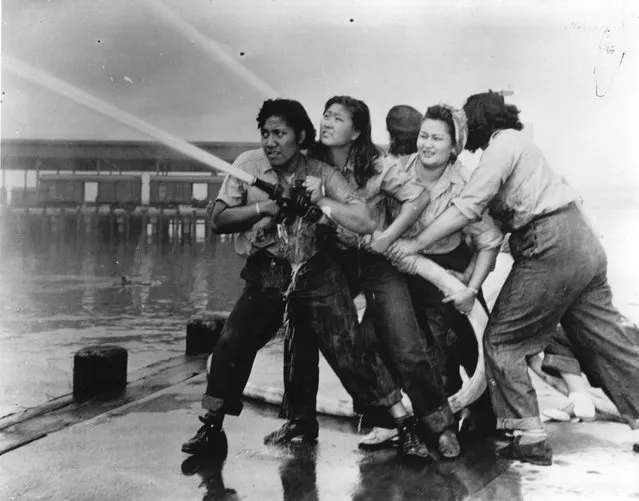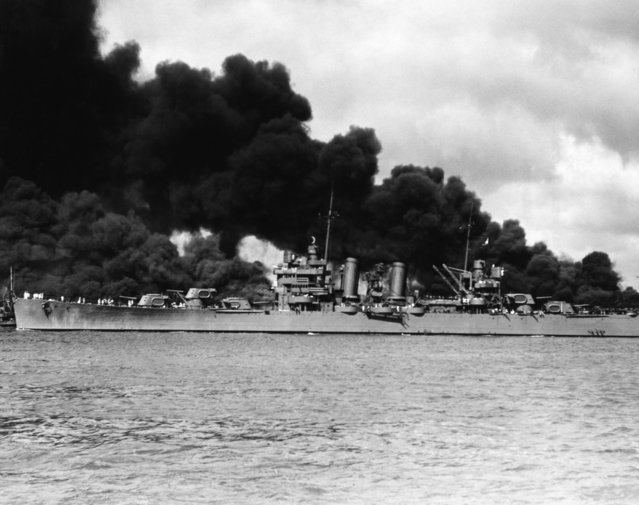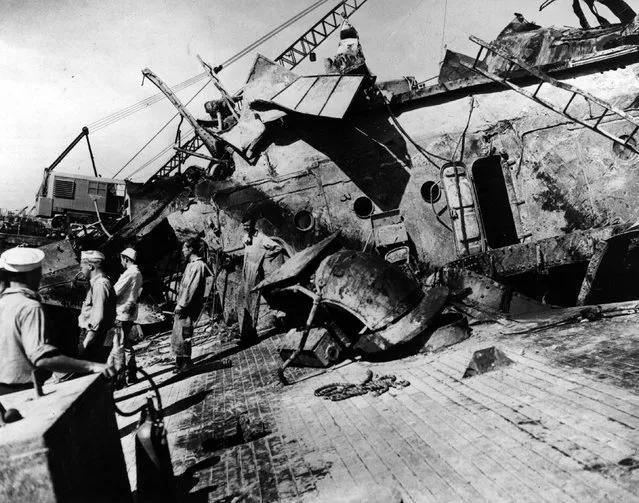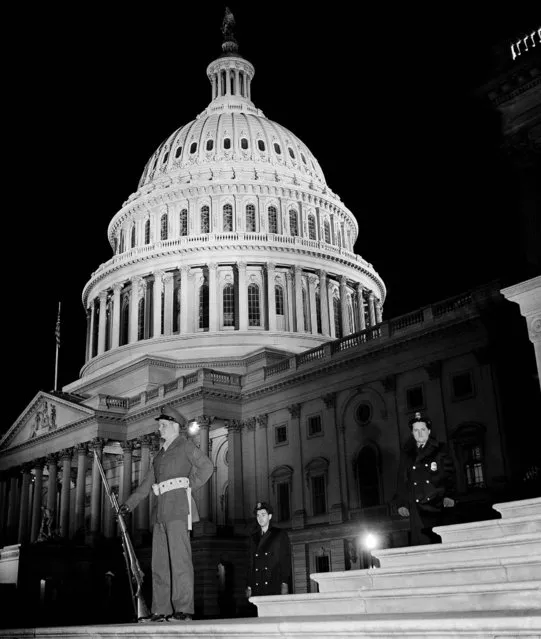“Pearl Harbor, known to Hawaiians as Puʻuloa, is a lagoon harbor on the island of Oʻahu, Hawaiʻi, west of Honolulu. Much of the harbor and surrounding lands is a United States Navy deep-water naval base. It is also the headquarters of the U.S. Pacific Fleet. The attack on Pearl Harbor by the Empire of Japan on December 7, 1941, brought the United States into World War II.
Aircraft and midget submarines of the Imperial Japanese Navy began an attack on the U.S. The Americans had deciphered Japan's code earlier and knew about a planned attack before it actually occurred. However, due to difficulty in deciphering intercepted messages, the Americans failed to discover Japan's target location before the attack occurred. Under the command of Admiral Isoroku Yamamoto, the attack was devastating in loss of life and damage to the U.S. fleet. At 06:05 on December 7, the six Japanese carriers launched a first wave of 183 aircraft composed mainly of dive bombers, horizontal bombers and fighters. The Japanese hit American ships and military installations at 07:51.
The first wave attacked military airfields of Ford Island. At 08:30, a second wave of 170 Japanese aircraft, mostly torpedo bombers, attacked the fleet anchored in Pearl Harbor. The battleship Arizona was hit with an armor-piercing bomb which penetrated the forward ammunition compartment, blowing the ship apart and sinking it within seconds. Overall, nine ships of the U.S. fleet were sunk and 21 ships were severely damaged. Three of the 21 would be irreparable.
The overall death toll reached 2,350, including 68 civilians, and 1,178 injured. Of the military personnel lost at Pearl Harbor, 1,177 were from the Arizona. The first shots fired were from the destroyer Ward on a midget submarine that surfaced outside of Pearl Harbor; Ward sank the midget sub at approximately 06:55, about an hour before the attack on Pearl Harbor. Japan would lose 29 out of the 350 aircraft they attacked with”. – Wikipedia
Aircraft and midget submarines of the Imperial Japanese Navy began an attack on the U.S. The Americans had deciphered Japan's code earlier and knew about a planned attack before it actually occurred. However, due to difficulty in deciphering intercepted messages, the Americans failed to discover Japan's target location before the attack occurred. Under the command of Admiral Isoroku Yamamoto, the attack was devastating in loss of life and damage to the U.S. fleet. At 06:05 on December 7, the six Japanese carriers launched a first wave of 183 aircraft composed mainly of dive bombers, horizontal bombers and fighters. The Japanese hit American ships and military installations at 07:51.
The first wave attacked military airfields of Ford Island. At 08:30, a second wave of 170 Japanese aircraft, mostly torpedo bombers, attacked the fleet anchored in Pearl Harbor. The battleship Arizona was hit with an armor-piercing bomb which penetrated the forward ammunition compartment, blowing the ship apart and sinking it within seconds. Overall, nine ships of the U.S. fleet were sunk and 21 ships were severely damaged. Three of the 21 would be irreparable.
The overall death toll reached 2,350, including 68 civilians, and 1,178 injured. Of the military personnel lost at Pearl Harbor, 1,177 were from the Arizona. The first shots fired were from the destroyer Ward on a midget submarine that surfaced outside of Pearl Harbor; Ward sank the midget sub at approximately 06:55, about an hour before the attack on Pearl Harbor. Japan would lose 29 out of the 350 aircraft they attacked with”. – Wikipedia

Japanese rear admiral Isoroku Yamamoto (1884–1943), commander and architect of the Japanese attack on Pearl Harbour (Pearl Harbor), circa 1937. (Photo by Central Press/Getty Images)

Japanese Vice-Admiral Chuichi Nagumo (left) commanded the Japanese combined air and sea power at Pearl Harbor. He was born in 1886 and committed suicide in July 1944. Admiral Isoroku Yamamoto (right) was the commander of Japan's Combined Fleet and planned the attack on Pearl Harbor. He was gunned down by the U.S. Army Air Force while inspecting the Northern Solomon Islands on April 18, 1943. Yamamoto was born in Japan in 1884 and studied at Harvard University in the U.S. (Photo by Associated Press)

Japanese bomber pilots receive their orders on board an aircraft carrier prior to commencing their mission of bombing Pearl Harbour (Pearl Harbor). 7th December 1941 (Photo by Keystone/Getty Images)

This photograph, from a Japanese film later captured by American forces, is taken aboard the Japanese aircraft carrier Zuikaku, just as a Nakajima “Kate” B-5N bomber is launching off deck for the second wave of the attack on Pearl Harbor on December 7, 1941. (Photo by Associated Press)

A Japanese bomber on a run over Pearl Harbor, Hawaii is shown during the surprise attack of December 7, 1941. Black smoke rises from American ships in the harbor. Below is a U.S. Army air field. (Photo by Associated Press)

Ford Island is seen in this aeriel view during the Japanese attack on Pearl harbor December 7, 1941 in Hawaii. The photo was taken from a Japanese plane. December 7, 2001 marks the 60th anniversary of the Japanese attack on Pearl Harbor. (Photo by Getty Images)

A Japanese dive bomber goes into its last dive as it heads toward the ground in flames after it was hit by Naval anti-aircraft fire during the attack on Pearl Harbor. (Photo by Associated Press)

A picture taken from a Japanese bomber showing another Japanese plane and plumes of black smoke on the ground during the attack on Pearl Harbour (Pearl Harbor). 7th December 1941. (Photo by Keystone/Getty Images)

The newspaper tells of bombing in downtown Honolulu an hour and a half after the attack on Pearl Harbour (Pearl Harbor) by the Japanese airforce. 7th December 1941. (Photo by Three Lions/Getty Images)

War bulletins describing the Japanese attack on the U.S. are posted in English and Chinese in New York's Chinatown in lower Manhattan, December 7, 1941. (Photo by Associated Press)

White House reporters dash for telephones after they had been told by presidential press secretary Stephen T. Early that Japanese submarines and planes had just bombed the U.S. Pacific fleet at Pearl Harbor. (Photo by Associated Press)

Employees of the Japanese Embassy in Washington close the main gates to their building after the announcement by the White House that Japan had attacked Pearl Harbor. (Photo by Associated Press)

White House reporters listen to the radio in the White House press room as Japan declares war on the U.S., December 7, 1941. (Photo by Associated Press)

Papers are sold at Times Square in New York City on December 7, 1941, announcing that Japan has attacked U.S. bases in the Pacific. (Photo by Robert Kradin/Associated Press)

The USS California on fire in Pearl Harbour (Pearl Harbor) after the Japanese attack. 7th December 1941. (Photo by Fox Photos/Getty Images)

The American destroyer USS Shaw explodes during the Japanese attack on Pearl Harbour (Pearl Harbor), home of the American Pacific Fleet during World War II. (Photo by Keystone/Getty Images)

Following the surprise attack by the Japanese on Pearl Harbour (Pearl Harbor) this US Army P40 pursuit plane was machine gunned on the ground at Bellows Field by the enemy. 7th December 1941. (Photo by Keystone/Getty Images)

An explosion at the Naval Air Station, Ford Island, Pearl Harbour (Pearl Harbor) during the Japanese attack. Sailors stand amid wrecked watching as the USS Shaw explodes in the center background. The USS Nevada is also visible in the middle background, with her bow headed toward the left. (Photo by Fox Photos/Getty Images)

Women fire fighters directing a hose after the Japanese attack on the US naval base at Pearl Harbour (Pearl Harbor). (Photo by Three Lions/Getty Images)

The USS Arizona burning furiously in Pearl Harbour (Pearl Harbor) after the Japanese attack. To the left of her are USS Tennessee and the sunken USS West Virginia. (Photo by Hulton Archive/Getty Images)

A small boat rescues sailors from the USS “West Virginia” after she had suffered a hit in the Japanese attack on Pearl Harbor. The USS Tennessee (BB-43) is inboard of the sunken battleship. (Photo by Fox Photos/Getty Images)

A small boat rescues a USS “West Virginia” crew member from the water after the Japanese bombing of Pearl Harbor. (Photo by Associated Press)

The American light cruiser USS “Phoenix” passing the burning USS West Virginia and USS Arizona, during the Japanese attack on Pearl Harbor, 7th December 1941. (Photo by Hulton Archive/Getty Images)

A general view of Pearl Harbour (Pearl Harbor) after it had been attacked by the Japanese. Smoke pours from USS Shaw (right centre) whilst the minelayer USS Oglana lies capsized in the foreground. 7th December 1941. (Photo by Keystone/Getty Images)

The battleship USS West Virginia is seen afire after the Japanese surprise attack on Pearl Harbor. (Photo by Associated Press)

Torpedoed and bombed by the Japanese, the battleship USS West Virginia begins to sink after suffering heavy damage (center) while the USS Maryland (left) is still afloat in Pearl Harbor. The capsized USS Oklahoma is at right. (Photo by Photo by U.S. Navy/Associated Press)

American ships burn during the Japanese attack on Pearl Harbor. (Photo by Associated Press)

The battleship USS Arizona belches smoke as it topples over during the Japanese surprise attack on Pearl Harbor. The ship sank with more than 80 percent of its 1,500-man crew, including Rear Admiral Isaac C. Kidd. (Photo by Associated Press)

Officers' wives, investigating explosions and seeing smoke in the distance, heard neighbor Mary Naiden, then an Army hostess who took this picture, exclaim “There are red circles on those planes overhead. They are Japanese!” Realizing war had come, the two women, stunned, started toward quarters. (Photo by Mary Naiden/Associated Press)

The horror of destruction at the US Naval Base of Pearl Harbour (Pearl Harbor) which was attacked by the Japanese airforce on the 7th December 1941. The destroyer “Shaw” is a tangled mess of wreckage but she was back in use one year later. December 1941. (Photo by Fox Photos/Getty Images)

The horror of destruction at the US Naval Base of Pearl Harbour (Pearl Harbor) which was attacked without warning by the Japanese airforce on the 7th December 1941. The attack took place whilst the Japanese were holding peace talks in Washington. More than 2000 servicemen were killed, and a large part of the US fleet destroyed. The attack caused the USA to join the war. This salvage crew is on the deck of the USS Oklahoma sunk on the night of the attack. (Photo by Keystone/Getty Images)

The jumbled mass of wreckage in front of the battleship USS Pennsylvania constitutes the remains of the destroyers USS Downes and USS Cassin, bombed by the Japanese during the raid on Pearl Harbour (Pearl Harbor). The ships were in drydock. The torpedo-damaged cruiser USS Helena is in the right distance, beyond the crane. Visible in the centre distance is the capsized USS Oklahoma with USS Maryland alongside. December 1941. (Photo by Fox Photos/Getty Images)

Wreckage of a US Navy amphibian plane being photographed. It was destroyed during the nearby Pearl Harbour (Pearl Harbor) attack. 10th December 1941. (Photo by Keystone/Getty Images)

Hickam Field aircraft hangar at Pearl Harbour (Pearl Harbor), Hawaii, destroyed by Japanese bombs during World War II. (Photo by Evans/Three Lions/Getty Images)

An American Seaman looks at the charred corpse of a Japanese flier brought up from the bottom of Pearl Harbor, where he crashed with his burning plane during the attack. (Photo by Associated Press)

U.S. Navy seamen examine the wreckage of a Japanese torpedo plane shot down at Pearl Harbor. (Photo by Associated Press)

Eight miles from Pearl Harbor, shrapnel from a Japanese bomb riddled this car and killed three civilians. The Navy reported there was no nearby military objective. (Photo by U.S. Navy/Associated Press)

Youths inspect the wreckage of a Japanese bomber, December 17, 1941 brought down by a United States P-40 plane during the December 7 attack on Oahu, Hawaii. (Photo by Associated Press)

The body of a Japanese Lieutenant who crashed during the attack on Pearl Harbor is buried with military honors by U.S. troops. This undated picture was released by the Navy Department in Washington. (Photo by Associated Press)

The shattered wreckage of American planes bombed by the Japanese in their attack on Pearl Harbor is strewn on Hickam Field, December 7, 1941. (Photo by Associated Press)

The wing of a Japanese bomber shot down on the grounds of the Naval Hospital in Honolulu on December 7, 1941. (Photo by Associated Press)

The front page of the “New York World Telegram”, with the headline, “1500 dead in Hawaii”, referring to the Japanese air attack at Pearl Harbour (Pearl Harbor) on the Hawaiian island of Oahu. 8th December 1941. (Photo by Express/Express/Getty Images)

Declaring Japan guilty of a dastardly unprovoked attack, President Franklin D. Roosevelt asked Congress to declare war, December 8, 1941. Listening are Vice President Henry Wallace (left) and House Speaker Sam Rayburn. (Photo by Associated Press)

Poster features a painting (by Allen Saalberg) of a torn and ragged American flag as black smoke billows behind it, accompanied by the text “...we here highly resolve that these dead shall not have died in vain...” and “Remeber Dec. 7th!” 1942. The quote is an excerpt from Abraham Lincoln's Gettysburg Address and references the Japanses attack on Pearl Harbor the preceeding year. (Photo by Hulton Archive/Getty Images)

Congressmen, cabinet members, Supreme Court justices, and others listen as a grim President Franklin D. Roosevelt asks for war against Japan: “With confidence in our armed forces – with the unbounding determination of our people – we will gain the inevitable triumph - so help us, God”. President Roosevelt spoke in the House of Representatives, addressing a joint session of Congress, December 8, 1941. (Photo by Associated Press)

“Japanese cabinet meets in emergency session”, is the bulletin shown in Times Square's news zipper in lights on the New York Times building, New York, December 7, 1941. (Photo by Robert Kradin/Associated Press)

Shortly after the Japanese attack in Hawaii's Pearl Harbor, young men line up to volunteer at a Navy Recruiting station, Boston, Massachusetts, December 8, 1941. (Photo by Hulton Archive/Getty Images)

U.S. President Franklin D. Roosevelt signs the declaration of war at the White House in Washington, D.C., December 8, 1941 at 3:08 p.m. EST. Watching from left to right are, Rep. Sol Bloom, D-N.Y.; Rep. Luther Johnson, D-Texas; Rep. Charles A. Eaton, R-N.J.; Rep. Joseph Martin, R-Mass.; Vice President Henry A. Wallace; House Speaker Sam Rayburn, D-Texas; Rep. John McCormack, D-Mass.; Sen. Charles L. McNary, R-Ore.; Sen. Alben W. Barkley, D-Ky.; Sen. Carter Glass, D-Va.; and Sen. Tom Connally, D-Texas. (Photo by Associated Press)

Attaches of the Japanese consulate began burning papers, ledgers and other records shortly after Japan went to war against the U.S., in New Orleans. Police later stopped the fire after most of the papers had been destroyed. (Photo by Horace Cort/Associated Press)

Ruth Lee, hostess at a Miami Chinese restaurant, is seen December 15, 1941. She didn't want to be mistaken for Japanese when she sunbathed on her days off, so she brought along a Chinese flag. Miss Lee was actually American-born. (Photo by Associated Press)

Customers of a five and dime store view the wreckage of Japanese-produced knick knacks, destroyed by the management, under a sign declaring ruin for the Rising Sun, December 9, 1941, in Milwaukee. (Photo by Associated Press)

Joy Cummings examines a Japanese cherry tree that was cut down had the words “To hell with those Japanese”, carved into it, December 10, 1941. Irving C. Root, Parks Commissioner, termed it vandalism. In the background is the recently completed Jefferson Memorial. (Photo by Associated Press)

Thomas Hart Benton painted this war bond poster for the U.S. government to support the war effort. Soon after Pearl Harbor, Benton began a series of paintings entitled “Year of Peril”, dedicated to awakening American people to the realization of what war meant. (Photo by Associated Press)

A Marine stands guard outside the Capitol in Washington, following the Japanese declaration of war on the United States, December 7, 1941. Aiding the Marines were Capitol police. (Photo by Associated Press)
07 Dec 2012 09:01:00,
post received
0 comments
